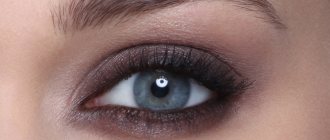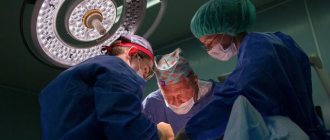Where do bedsores occur?
Most quickly, bedsores in bedridden patients form on the back, back of the head, areas behind the ears, elbows, shoulder blades, buttocks, hips, ankles and heels. In people who are forced to lie motionless on their stomach for a long time - in the areas of the knees, the anterior surface of the chest, and the iliac crests. When lying on your side for a long time, the area of the lateral surface of the leg, shoulder and ilium is primarily affected.
A bedridden patient developed bedsores. What to do?
Those who begin to care for a bedridden patient face many difficulties, and one of them is how to prevent the formation of bedsores on the body. Andrei Igorevich Anikin, Candidate of Medical Sciences, Head of the Department of Purulent Surgery at City Clinical Hospital No. 17 in Moscow, answers questions about the development and prevention of bedsores.
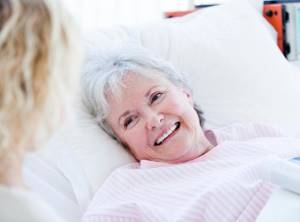
“My mother recently suffered a stroke. She is now a bedridden patient. The upcoming care for her scares me. I'm especially afraid of bedsores. Why are they formed? After all, after sleep, such problems do not appear on the body of an ordinary person.”
If a person lies or sits for a long time in one motionless position, then the areas of the body that come into contact with the bed, mattress, or wheelchair seat experience constant pressure. A healthy person, feeling that his hand is numb from an uncomfortable position, will immediately begin to move. An immobilized patient, as you understand, cannot do this. Due to inactivity, blood supply is disrupted and oxygen and nutrients stop flowing to the compressed area. And tissue necrosis occurs.
When the patient is forced to lie on his back, bedsores form in the places where the bones are closest to the skin - on the elbows, back of the head, shoulder blades, spine, sacrum, buttocks. If a person constantly lies on his side, the shoulders, knees, lower back and cheekbones may suffer from bedsores. For someone who spends most of their time in a wheelchair, their shoulder blades, buttocks and heels are vulnerable.
With age, blood circulation deteriorates, tissues lose the ability to quickly recover, so bedsores form more quickly in older people. They occur more often in malnourished patients, since weight loss results in the loss of muscle and fatty tissue, which act as layers between the bony protrusions and the skin. Bedsores are dangerous for diabetics - like any wounds, they do not heal well.
“In our family, our grandfather has been sick for a long time. Not long ago he fell ill. The other day I noticed that a red spot appeared on the skin of my buttocks. Is this a bedsore?
At first, a red or crimson spot actually appears on the skin. When pressed with a finger, it does not turn white. And if no measures are taken, very soon a painful wound will form in this place. Then deep soft tissues are exposed, and over time muscles, joints, and bones are visible. In the most severe stages, pus appears.
“Why does an ordinary cut on the skin heal quickly, but a bedsore heals slowly?”
A bedsore is different from a cut. An ordinary wound, if properly cared for, will easily heal its fresh edges. And at the site of the bedsore, tissue death has occurred, so healing occurs very slowly.
“Are there any effective measures that need to be taken to prevent the patient from developing bedsores?”
Unfortunately, you do not write whether your relative is bedridden or whether he has to stay in a wheelchair for a long time. If he is lying in bed, the most important thing is to change his position at least every two hours so that the areas of the body that are in contact with the bed do not experience pressure. Turn the patient on his right side, then blood supply will be restored in the left side of the body. And vice versa.
If this is difficult to do, it is enough to change the position even a little, literally by a few degrees, placing support under your back in the form of a blanket or sheet, but be sure to not have any lint or folds. If the patient is forced to sit in one position for a long time in a wheelchair, shift his weight. Tilt him to the right, place a pillow for comfort so that he sits on his right leg. Then tilt to the left to change position and avoid getting bedsores on the buttocks and sacrum.
You can massage the area prone to the formation of bedsores. Be sure to keep the problem area clean and dry. This is especially true if a person is forced to lie in diapers. If the patient cannot be washed in the shower, dry him in bed with wet wipes and then wipe him dry. The skin will breathe - blood supply will be restored.
When changing bed linen or underwear - pajamas, nightgown, try to ensure that there are no wrinkles on them. In weakened people, the skin is flabby and easily moves, forming folds on itself. In these places, bedsores occur, as if from contact with the bed.

“I looked after my aunt as expected. However, bedsores have already formed. What to do now? What is better to apply - brilliant green, sea buckthorn oil and baby cream?
The main rule of care is that a person should not lie or sit on bedsores. If the problem appears on the back or buttocks, and a bedridden patient cannot be seated - he can only be on his side or back, try to make sure that the bedsore does not come into contact with the bed. It is good to use additional devices. You can buy special circles, bagels, pads at the pharmacy or online to change the pressure on areas of the body. If this equipment is made of rubber, be sure to cover it with a cloth to prevent the skin from rotting when it comes into contact with the surface.
You can lubricate a bedsore with brilliant green, iodinol (an aqueous solution of iodine) and other antiseptics - miramistin, chlorhexidine. Sea buckthorn oil will not help. And it’s good to apply baby cream not to the bedsore itself, but to the skin around it so that it is moisturized and does not dry out.
“A neurologist advised me to buy an anti-decubitus mattress to care for my elderly relative. Pleasure is not cheap. But I’m ready to buy it if it really helps a sick person.”
An anti-bedsore mattress is useful and really helps to avoid bedsores. It consists of connected air cylinders. They inflate unevenly and create varying pressure at different points. The principle of operation of the mattress is that it locally changes the points of its contact with the body of the person lying down.
But do not delude yourself that now everything will be fine with your relative, since he is lying on a special mattress. If you do not regularly move the patient and provide him with hygiene procedures, bedsores will appear anyway.
“What to do if the bedsore becomes inflamed and festers?”
If the bedsore of a bedridden patient is inflamed and pus appears, you cannot do without the help of a surgeon. He must prescribe treatment - ointments, injections and powders. It is imperative to change the bandages, keep the body clean and continue to try to ensure that the person does not lie on the problem area.
In case of development of purulent complications with bedsores, the patient must be hospitalized. If large areas of dead tissue form or suppuration occurs, the patient is operated on. Non-viable tissue is removed, dressings are performed, antibiotics, anti-inflammatory and restorative treatment are prescribed.
Once the inflammation around the pressure ulcer has subsided, the patient is discharged from the hospital for further care by the outpatient surgical service.
In the department of purulent surgery of City Clinical Hospital No. 17, patients with bedsores are provided with care every day. At the first stage of treatment, we perform necrectomy (removal of non-viable tissue), apply staged dressings with modern wound dressings, and use vacuum therapy. At the second stage, some patients (mostly young patients after a spinal injury, wheelchair users, patients whose bedsores arose as a result of a long stay in intensive care) undergo plastic surgery with displaced fasciocutaneous flaps.
15 years ago, my recent patient suffered a serious spinal injury. Now he is already 68, and about a year ago the man developed bedsores on his buttocks. It was decided to first perform skin grafting of the pressure ulcer of the left sciatic region. The bedsore was excised along with scar-altered surrounding tissues. And a fasciocutaneous flap from the back of the thigh was applied to the site of the pressure sore defect. The stitches were removed two weeks later. The healing went well. In two months, we plan to perform a second operation on this patient - for a pressure sore on the right buttock.
Of course, we must try to prevent bedsores, but if they form, the capabilities of modern surgery make it possible to cope with them.
How to prevent it?
- Make sure that you have easy access to the bed of a seriously ill patient (preferably from both sides), and that it is in a well-lit place (to monitor skin condition). Ideally, the bed should have an adjustable height and an anti-bedsore mattress.
- When changing underwear, diapers, or washing a bedridden person, inspect his skin in risk areas.
- Keep your skin clean .
- If a person complains of pain, a burning sensation or pressure in any area, this may be the first symptom of a bedsore.
- Do not massage the reddened area! This can lower the temperature of the skin and lead to tissue degeneration and pressure sores.
- Change the patient's body position every 2-4 hours. If the person is able to move on his own, remind him to do so more often.
- If possible, the person in bed should do exercises for the legs and arms (to speed up blood circulation).
- Body position needs to be changed at night as well . Suitable poses: on the side, on the back, on the stomach and half-side. To fix the body in the desired position, make supports from pillows and blankets .
- Raise the head of the head by 30 degrees only during meals or grooming procedures. When it is raised, a lot of pressure is placed on the buttocks, which increases the risk of pressure sores.
- When laying the patient on his side, place a pillow from the groin area to the foot under the slightly bent upper leg of the person lying down.
Treatment with herbal remedies
Traditional recipes help further cleanse the wound surface, prevent complications, and gently stimulate the formation of new tissue. When choosing a specific folk remedy, you need to know that it can cause allergies.
To avoid negative consequences, you need to try a new product on a small area of healthy skin, and only after that treat the wound surfaces. A preliminary consultation with your doctor will not hurt.
Important! All folk remedies can only be used as additional treatment. They cannot eliminate the need for constant use of medications prescribed by a doctor!
To cure deep bedsores on the tailbone, buttocks and other areas, and to prevent complications, it is unacceptable to use products with pronounced tanning properties.
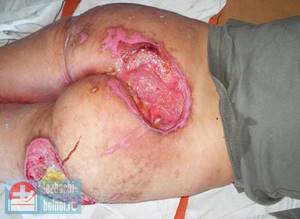
Among the safe means indicated for the treatment of large and deep bedsores, the following should be listed:
- the juice of their fresh lungwort leaves, which need to treat areas of inflammation daily;
- Kolanchoe leaves divided in half are applied cut side to the bedsore, gently fixed with a bandage and left overnight;
- elderberry leaves, pre-treated with boiling milk;
- mix Vaseline with crushed calendula flowers, apply the resulting composition to the wound surface in a thin layer twice a day;
- treatment of complex bedsores can be supplemented with lotions made from freshly grated potatoes with the addition of honey - the same remedy helps prevent the occurrence of such a problem;
- Treating deep bedsores with tea tree oil also helps (sea buckthorn can also be used);
- compress of fish oil (pre-boiled and cooled);
- a mixture of celandine and aloe juice with honey - proportions 2: 2: 1.
If the area of the bedsore is significant and the surface is very wet, you can try starch powder. During treatment with herbal remedies, it is necessary to constantly monitor the person’s reaction, and if local negative effects appear on the remedy, its use should be stopped immediately.

Aids
Mattress with compressor (anti-decubitus system) . They come in two types: cellular - intended for the prevention of bedsores (cost about 100 rubles) and tubular - used for the treatment of deep bedsores (280-300 rubles).
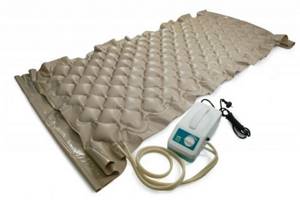
Rubber backing circles - an inflatable rubber ring with a valve for filling with air (from 8.70 rubles). They are placed under the sacrum, elbows, heels - depending on the size.
Cushions, soft foam pillows. They can additionally be placed under the elbows, knees, shoulder blades, and heels.
Bags filled with round grains (eg millet, rice). Can be sewn and placed under motionless limbs.
The point of using various bolsters and anti-decubitus mattresses is that they increase the area of contact between the body and the surface on which a person lies, which means that the pressure on each part of the body is reduced, which improves blood circulation.
A belt can be attached to the bottom of the bed so that a person can pull himself up to sit down on his own. Or build a trapezoid over (the so-called “goose”) at the head of the bed, which you can grab onto and stand up.
If a person does not have enough muscle activity to stay in a sitting position, provide support for his legs using bolsters or blankets .
Surgery
Surgery is performed solely for medical reasons. This is due to the fact that if it is inappropriate at the moment, or is performed incorrectly, the risk of increasing the area of inflammation and developing complications increases sharply. The intervention is carried out only in a hospital setting.
For this purpose, autodermoplasty, plastic surgery with local tissues are used; excision of a deep bedsore can be carried out, followed by comparison of the edges. The affected tissue does not take root well enough in those areas where blood circulation is severely impaired. Therefore, surgical intervention does not always guarantee a good result.
It should be noted that insufficient postoperative care is fraught with the development of complications. Among the early complications, it is necessary to note the accumulation of inflammatory exudate under the skin flap, suture dehiscence, necrosis along the edges of the skin flap, and bleeding of varying intensity. Late complications include a fistula, which turns into a large cavity, often with purulent filling. Relapses are common.
After surgery, constant dressings and careful wound treatment are required. To facilitate care and prevent complications, you can use pharmaceutical products.
| A drug | Application |
| Proteox-TM with trypsin and mexidol | Indicated in the later stages, especially with secondary infection. Accelerates the removal of pus and necrotic formations from the wound, stimulates tissue regeneration, eliminates the inflammatory process |
| Multiferm – enzymes and chitosan | Used as an adjuvant for the treatment of extensive bedsores with mild weeping |
| Biaten AG (Denmark) | Prescribed for the treatment of large bedsores with signs of secondary infection and extensive weeping |
| Comfil plus (Denmark) | Help for people with large uninfected areas and little discharge |
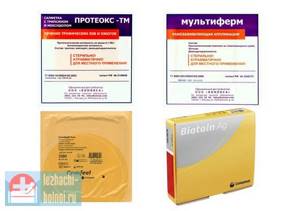
Bed sheets
It is advisable to use bedding and underwear made from natural materials that absorb moisture and allow air to pass through. It needs to be changed every day.
Avoid folds, bumps and crumbs in the bed as these can damage the skin.
Avoid rubber and oilcloth linings - they roll up and pinch the skin and do not allow air to pass through.
Absolutely forbidden:
- pull up a person who is lying down alone if he cannot help;
- dragging and pulling out underwear from under the patient, especially wet ones;
- push a vessel under a person.
Skin care
Cleanse the patient's skin delicately using special care products.
Avoid strong cosmetics.
Do not forget about the hygiene of the patient’s intimate areas - clean them with delicate products and protect them every time you change the diaper.
Do not use bar soap, but use washing lotion or foam (these can be purchased at pharmacies). These products just need to be applied to the contaminated area of the body for a few minutes, then wipe clean with a damp cloth or towel. No need to rinse!
Do not rub or massage the area where bedsores occur; only lightly blot it.
In case of too wet skin (urinary or fecal incontinence, excessive sweating), you need to use diaper rash creams and powders without talc.
If you are doing a massage, do not rub the area within a radius of at least 5 cm from the bony protrusion. Massage is carried out only after generous application of nourishing moisturizer to the skin.




